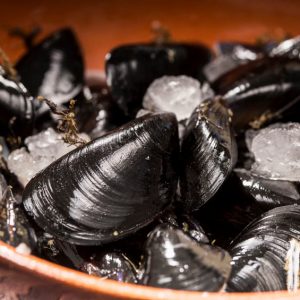
INTRODUCTION TO MUSSELS
( Le Cozze - I Mitili )
On the Eastern coast of North America, from Canada to New York, the blue mussels are commercially harvested in great quantity. The sweet taste, the rich texture and the scent of the sea make the mussels a favorite food to serve as appetizer, entrée or as a condiment to pasta dishes.
At la Focacceria Palermitana, Joe’s of Avenue U, in Brooklyn, NY, mussels in the sauce were served every day, moreover, we preferred to use Canadian mussels cultivated in Prince Edward Island, called PEI.
The PEI are farmed in clean and pollution free sea waters, they are fed with natural food sources and cultivated with a system to produce not only tender and flavorful mussels of high quality, but cleaner shells and grit free flesh. The Canadian mussels are available fresh, cleaned and debearded, on the Eastern seaboard and in many parts of the U.S.A.
Wash the mussels with running water; carefully protect your hands to eliminate the beards using a knife and scrape the outside to remove any incrustations on the shells. The beard is a little string that the mussels use to cling to the rope where they are cultivated.
Make sure that the mussels are fresh and they are tightly closed; they should be light, without sand inside; if they are open, they should instantly snap shut when tapped. Discard any mussel with a broken or chipped shell.
Keep mussels refrigerated in an open container, covered with a wet rag or ice and when ready to use, soak in salted water for at least ½ hour to allow the mussels to breathe and to eject any sand. Transfer mussels into a bowl with cold water, one at a time: use a small knife or a little brush to check and remove any beard, or barnacles. Now mussels are ready for the last wash and to be cooked.
RECIPES WITH MUSSELS
